In our last blog we explored the link between wellbeing and productivity and how investing in people’s health improves business performance. While the evidence supports employee wellbeing as an opportunity for development, the economic impact of the pandemic may prevent leaders from taking the next step. So if you’re looking to make wellbeing a priority in the post-Covid workplace, how can you win buy-in and support from senior leaders in your team?
Barriers to getting started with wellbeing
While 81% of HR leaders say the pandemic has made wellbeing a priority in their organisation, implementing new ways of working can be a challenge. Effective wellbeing strategies require time and investment and, while Covid-19 has seen new procedures rushed in, only 36% of organisations plan to expand on this work by increasing their wellbeing spend in 2021.
HR leaders report that cost and workplace culture are the most common barriers to new wellbeing initiatives. In fact, 59% of HR leaders say they would like to be able to do more in terms of wellbeing but company culture prevents it.
As the country emerges from lockdown, business leaders may be cautious about increasing their investment, but the value of wellbeing programmes is increasingly clear to the HR teams and managers who implement them. To win over leadership teams, wellbeing strategies must be accompanied by robust data which demonstrates a clear return on investment.
Finding your wellbeing advocates
Each organisation will have its own approach to wellbeing, so a useful first step is to identify the key people involved. Finding right people to advocate for wellbeing is often an effective way to bring about change.

The majority of HR leaders (56%) report that senior management, such as HR Directors, are responsible for wellbeing in their organisation. Almost a quarter (24%) of wellbeing strategies are owned by the CEO or board members, and in 12% of businesses this responsibility sits with the HR team.
In some cases, wellbeing is simply handled by those who decide to prioritise it. Often this results in an ad-hoc strategy which is taken on as an additional responsibility by one or more employees.
It may be helpful to identify a wellbeing ‘champion’ in your senior management or leadership team. This person should be engaged with the company vision and able to influence culture change with wellbeing in mind. Involving multiple departments is a great way to make sure your plans are well-received throughout the business. This also provides an opportunity to gather feedback for reports and make changes along the way.
Using the right language
Once you’ve identified your key people, it’s important to think about how best to convey your plans – and your achievements. Like a business report or financial plan, wellbeing strategies have the potential to influence every aspect of the business and should be pitched in much the same way.
Gather data that demonstrates the impact of your plans. Targets will be unique to each organisation, but they should reflect your wider vision and show how wellbeing is driving employee health, engagement and productivity. Try collecting employee testimonials and anecdotes alongside quantitative KPIs to present a thorough overview of the impact of your efforts and win buy-in from the top.
Effective strategies will combine wellbeing with other business priorities to create a solid foundation for recovery. HR leaders who take a data-driven approach will see wellbeing transition from a ‘nice to have’ to an essential business priority. While the end of lockdown brings further uncertainty, it also presents leaders with a rare opportunity to invest in wellbeing, influence culture change and help their people to perform at their best.
For more research into wellbeing’s role in business recovery, download our free Coping after Covid report or join our webinar:
How to create a wellbeing culture and boost employee productivity
Thursday 22nd April, 12.00 – 12.45 pm
Our expert panel will discuss how to help your employees recover from the business impact of Covid and create a more agile and resilient workforce.
What you’ll learn:
- The impact of Covid on businesses
- How wellbeing can support employees and alleviate issues such as poor productivity, presenteeism, absenteeism and stress.
- Putting a business case together for a wellbeing strategy that works
- How to nurture employee buy-in and develop a wellbeing culture
- Live Q&A and free resources